2017 Kawasaki Zx10rr Top Speed
Kawasaki ZX-10RR Ninja Homologation Special
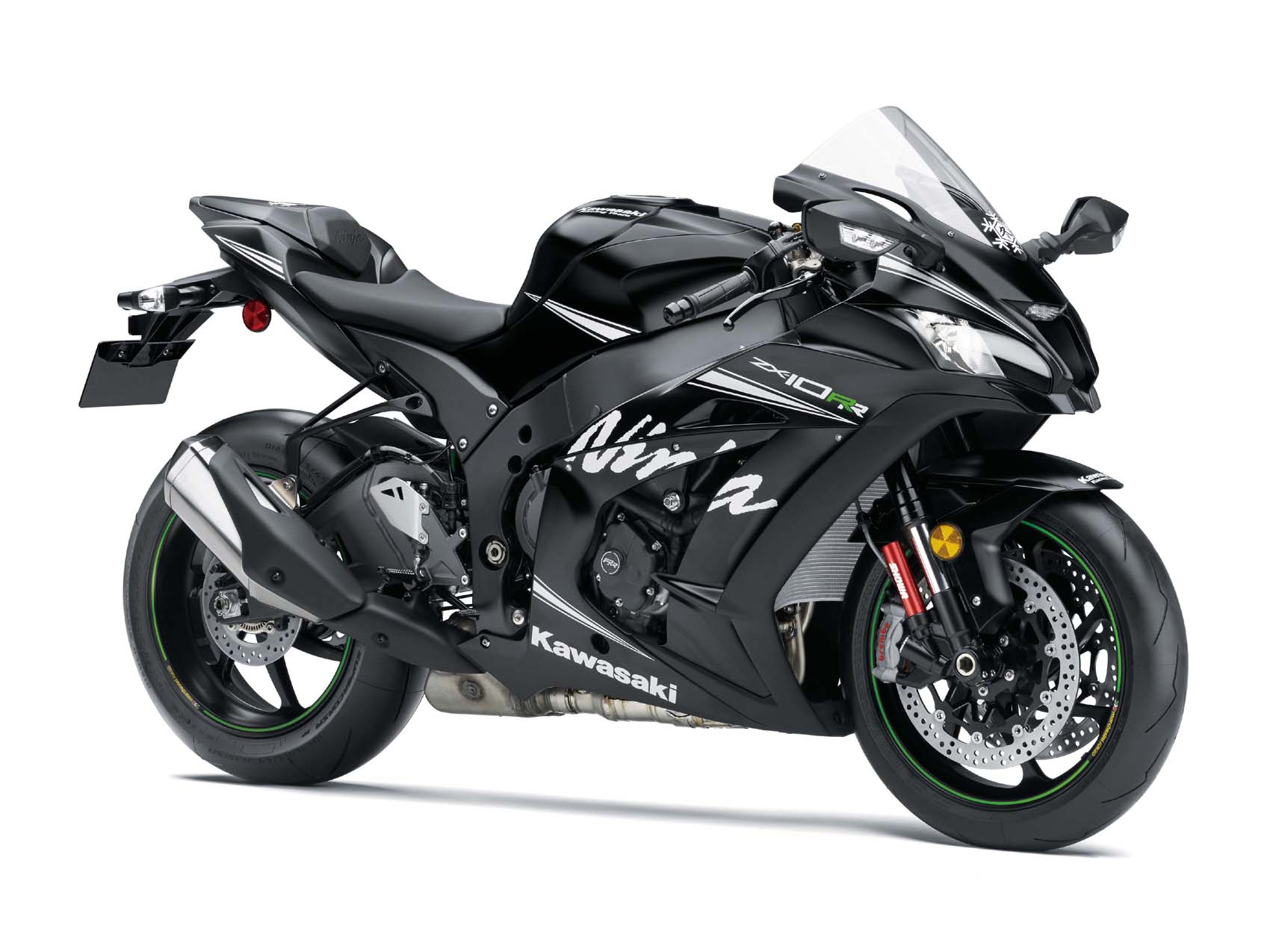
The Kawasaki Ninja ZX-10R motorcycle has solidly dominated the FIM Superbike World Championship (WorldSBK) with overall championship wins in 2013, 2015 and 2016. With the unveiling of the all-new Ninja ZX-10R supersport motorcycle in 2016, Kawasaki was able to bring riders even closer to the championship-winning race machine found on the WSBK racetracks. Now sharing more engineering advancements from this world-class racing team, Kawasaki is able to trickle down technology to produce and even faster, stronger and more race-focused model�introducing the track-ready 2017 Ninja ZX-10RR sportbike, getting riders closer.The 2017 Kawasaki Ninja ZX-10RR
-
race ready engine upgrades featuring increased engine case strength, increased cam clearance, and DLC coated tappets to reduce mechanical power loss in race tuned engines
-
7-spoke multi-directional forged aluminum Marchesini� wheels
-
updated KQS ( Kawasaki Quick Shifter) now allows for clutchless downshifting
Here are the top five differences between the ZX-10R and ZX-10RR
Different livery
The most obvious visual difference is the paint scheme. The Ninja ZX-10RR gets the Winter Edition livery inspired by the company�s WSBK team. It has a snowflake logo on the tail cowl and the windscreen, and the RR logo embossed into the pulser cover on the engine. It even gets a special key with the RR badge.
Upgraded engine internals
It is powered by a similar 999cc 200-horsepower inline four engine, albeit with a few upgrades. The head has been modified to accommodate the high-lift cams, and there are DLC-coated tappets to reduce friction. It also has stiffer valve springs.
Lighter wheels
The Ninja ZX-10RR rides on lightweight seven-spoke Marchesini wheels. Lighter wheels reduce the unsprung weight of the bike and improve the handling.
Stickier tyres
The Ninja ZX-10RR is equipped with super-sticky Pirelli Supercorsa SP tyres to improve the cornering grip, thereby allowing you to go faster around a corner at the track.
Revised suspension
The Ninja ZX-10RR�s suspension setup has been revised taking into account that it is offered only as a single-seater and to suit the Pirelli tyres. Kawasaki claims that the ZX-10RR has smoother weight transfer and less pitch than the standard model, which gives you the confidence to go faster on the track.
Overview
suited for street use. The Ninja ZX-10RR meets emissions regulations and featuring proper street lighting, and features an engine tune that�s suitable for street riding.
The Ninja ZX-10RR motorcycle doesn�t hide the fact that it�s a purpose-built machine, the purpose, even faster lap times. The Ninja ZX-10RR is designed as a single-seat model, keeping with its race-ready priority. Lack of passenger footpeg mounts and a rear seat, along with a lightweight exhaust mount, contribute to weight savings. The single-seat cover, which comes standard, also contributes to the bike�s racy image. The KRT (Kawasaki Racing Team) Winter Test snowflake logo on the cover matches the one on the windscreen.
Every model will feature a �RR� logo stamped/engraved into the side cover to further distinguish the Ninja ZX-10RR from the standard model. The ignition key is also adorned with a �RR� logo, adding another special touch. The 2017 Ninja ZX-10RR comes standard with ABS.
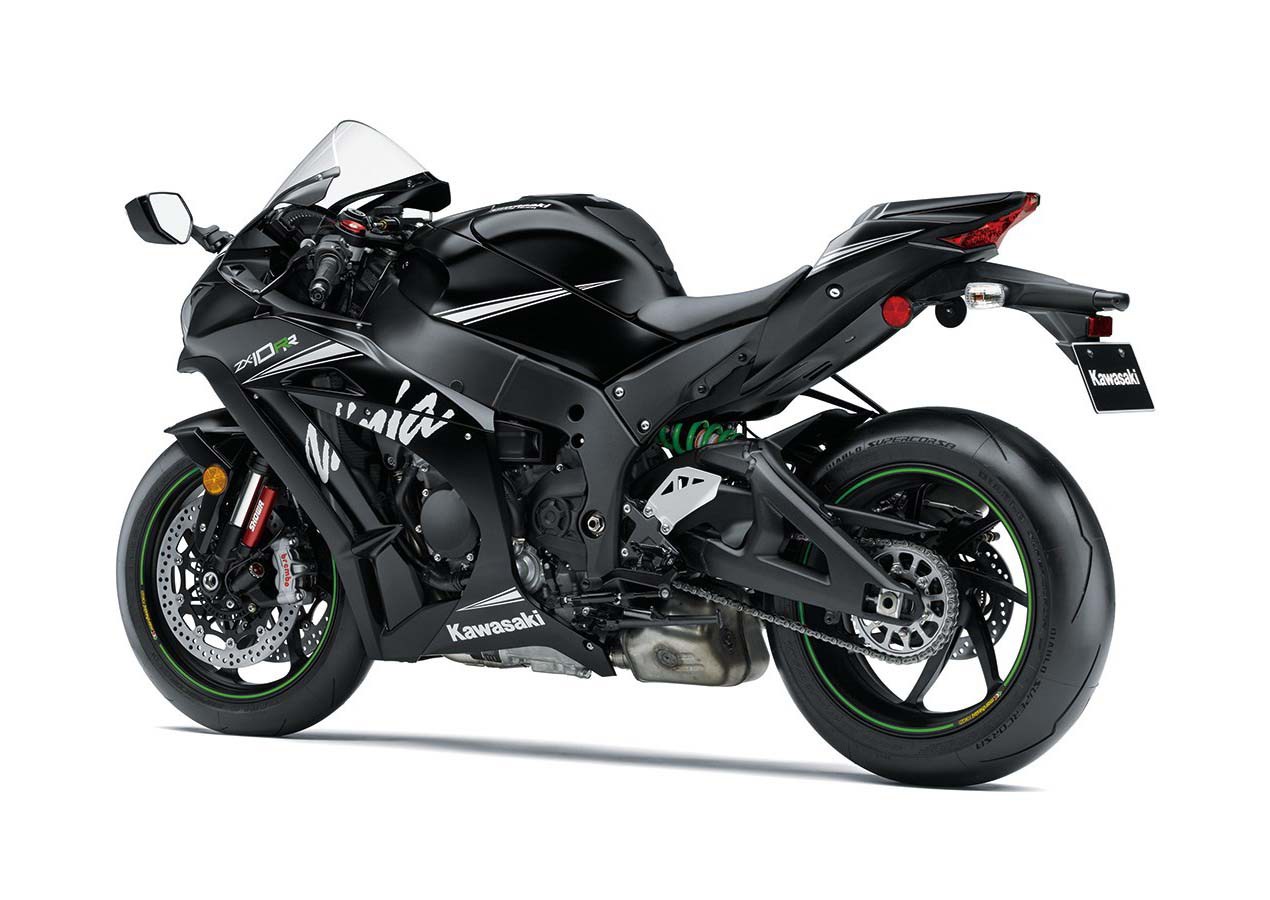
ENGINE
-
Powerful 998cc in-line four-cylinder 16-valve engine
-
Lightweight crankshaft allows for quick revving and great low-mid-range power
-
Computer-controlled electronic throttle valve delivers precise control
-
Engine enhancements to create a motorcycle even closer to its WorldSBK-winning counterpart
-
Stronger, reinforced engine cases
Using the potent 2016 engine as the starting point, the Ninja ZX-10RR sportbike features added improvements, creating an even stronger performing platform. Changes offer enhanced reliability under racing conditions, the results of feedback from Kawasaki�s racing efforts in the Superbike World Championship.
The Ninja ZX-10RR is a true race machine, keeping the performance features of its standard sibling, but with enhanced features true racers will appreciate. For instance, the cylinder head is redesigned to give clearance for race-kit high-lift cams, also the crankcase has high rigidity reinforcements.
Another engineering development derived from Kawasaki�s WSBK racing efforts includes DLC (Diamond-Like Carbon) coating on valve tappets, which facilitates mid/long-distance engine break-in, and offers reduced mechanical loss and increased performance for a race-tuned engine (i.e. tuned for high performance).
The architecture of the proven 998cc engine retains its 16-valve, DOHC, inline four-cylinder layout and its over-square 76 x 55mm bore and stroke dimensions.
The Ninja ZX-10RR motorcycle features a lightweight crankshaft, which allows for quick revving and great throttle response and acceleration. It also has ideal low- and mid-range power output, which is appreciated when exiting a corner on the racetrack or on a favorite stretch of blacktop. Another advantage of the reduced reciprocating mass is better cornering turn-in and easier side-to-side transitions.
The cylinder head design incorporates additional clearances for the accessory race-kit larger cams, as well as large coolant passageways like on the standard model, to help provide engine reliability. Long-reach spark plugs are another part of the package, helping to boost ignition efficiency.
Electronic throttle valves allow precise control of the intake airflow, contributing to efficient power delivery and seamless integration of the electronic aids such as the Sport-Kawasaki TRaction Control (S-KTRC), the new Kawasaki Launch Control Mode (KLCM) and Kawasaki Engine Brake Control (KEBC).
The titanium-alloy exhaust system helps with weight reduction and mass centralization as well as the power to weight ratio by removing significant weight from the bike.
Titanium-alloy headers use a special heat-resistant alloy, which is unique to Kawasaki in a motorcycle application and feature a connector pipe joining headers three and four to help smooth the engine response. The heat handling capacity contributes to durability, while the alloy also allows thinner pipes thickness, reducing weight even more.
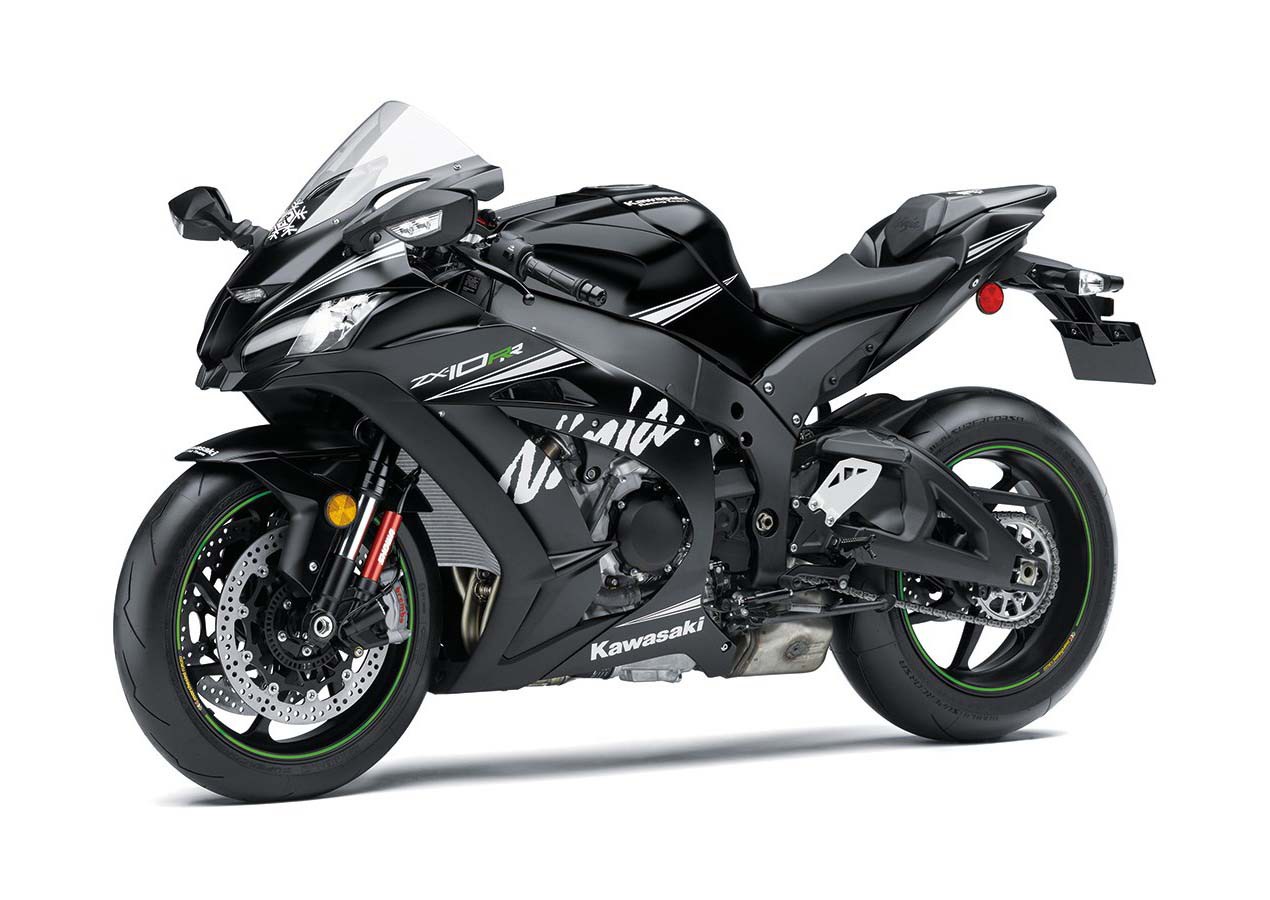
TRANSMISSION
-
Clutchless downshifts via KQS quickshifter
The Ninja ZX-10RR features the same great cassette-type, close-ratio transmission as the Ninja ZX-10R motorcycle. The gear ratios are idealized for circuit riding. Short ratios for second through sixth gear deliver strong corner exit acceleration. The close ratios also give stable downshifts and works with a slipper clutch.
Formerly, the Ninja ZX-10R allowed clutchless, auto-blip downshifts only through fitment of race kit parts; now the Ninja ZX-10RR provides that as a standard feature. This allows quick upshifts and downshifts without the need of a clutch, nor does the rider need to match RPMs. This results in a more enjoyable experience and quicker lap times.
KAWASAKI ELECTRONICS SYSTEMS
The 2017 Ninja ZX-10RR motorcycle uses a full complement of electronics that allow the rider to fully explore its performance on the track. The Kawasaki electronic system uses a proprietary algorithm that optimizes the electronic stability systems. The Kawasaki system uses a Bosch five-axis Inertial Measurement Unit (IMU) with software developed in-house, drawing on the KRT World Superbike experience, making this application unique. For example, it takes the pitch and roll rate data measured by the IMU, and the ECU calculates the yaw rate, resulting in six-axis operation. It provides an additional layer of precision to the already high-level electronics package, giving riders greater confidence on the track by allowing them to explore limits within the parameters controlled by the on-board computer.
Specifically, the IMU is able to measure longitudinal acceleration and braking, transverse or lateral forces when cornering, vertical acceleration such as when cresting a hill at steady speed, rotational roll rate (or lean angle) as well as the pitch rate such as during a wheelie or under hard braking. The Kawasaki software adds the sixth axis with yaw rate calculations, such as experienced during a powerslide where the rear wheel is out of line with the front.
The IMU input into the ECU works in conjunction with wheel speed, brake pressure, throttle position, engine RPM and throttle opening sensors. This high level of chassis orientation awareness means the ECU can adapt to changes in tires and even road camber. This gives the Kawasaki system an advantage because the S-KTRC, KLCM, Kawasaki Intelligent anti-lock Brake System (KIBS) and Cornering Management Function can respond to real-world conditions in real time, rather than relying solely on pre-set limits like other systems.
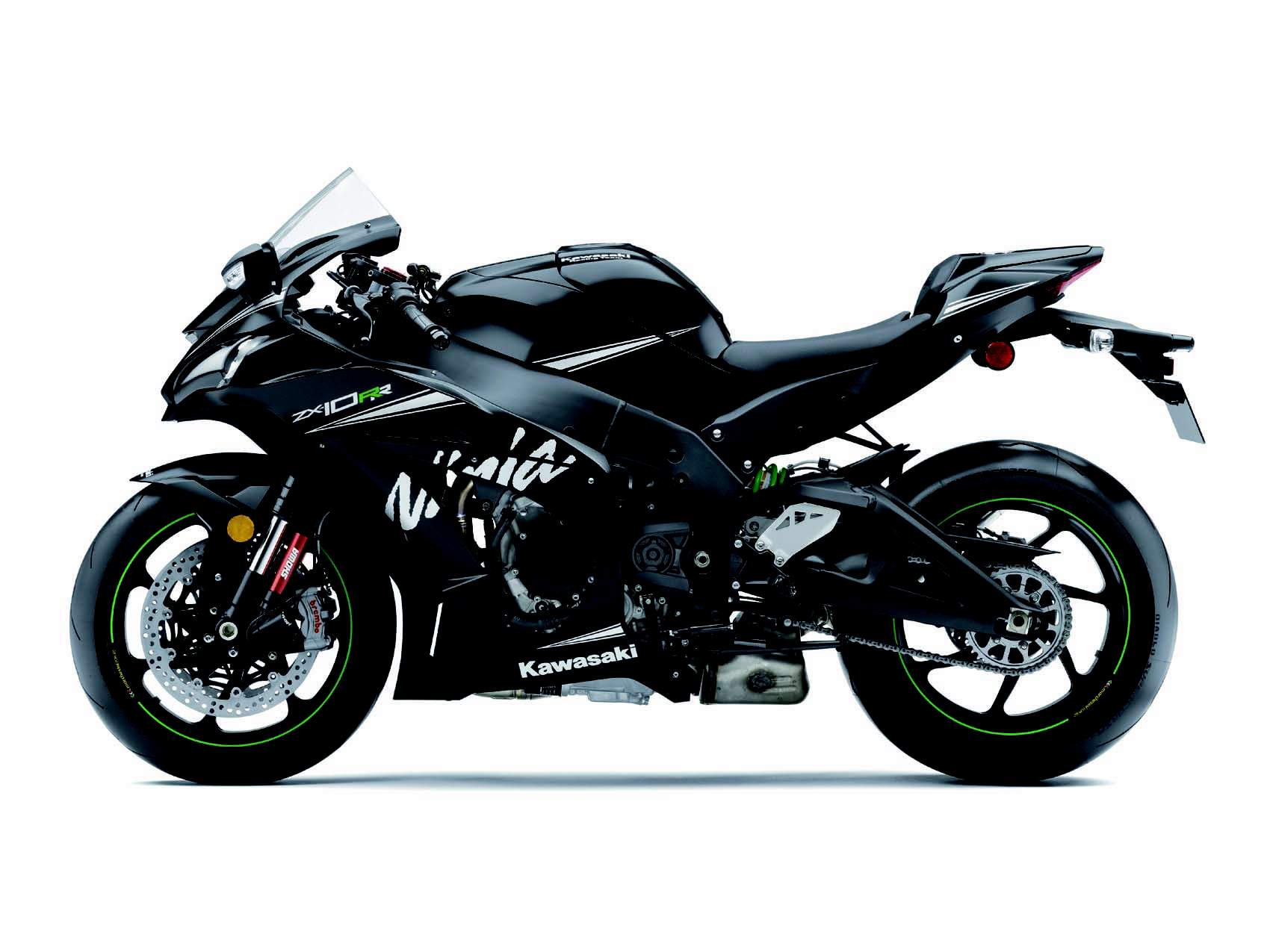
S-KTRC Sport-Kawasaki TRaction Control
The Sport-Kawasaki TRaction Control system has five modes of intervention. Modes one and two are designed for an expert racer on the track who prefers some degree of slip control, albeit with minimal intrusion. Mode three is designed for a dry circuit with high-grip tires. Mode four is intended for dry canyon roads or commuting, while mode five is programmed to suit wet circuit or street use. Full power and full slip can be attained by simply switching the TC �OFF� for those victory lane burnouts!
The inclusion of the IMU means that S-KTRC changes from being a purely predictive system to one that also offers feedback. This predictive/feedback system offers even more precise management to help riders push harder on the racetrack by maximizing acceleration.
The highly sophisticated traction control system is based on racing technology and acknowledges that in order to accomplish the quickest acceleration, a certain amount of tire slip is required. In order to optimize traction, S-KTRC varies slip according to the prevailing conditions, taking information from a number of parameters to get a real-time image of what is happening. As such, it looks at front and rear wheel speed (slippage), engine RPM, throttle position, acceleration, etc. The system also looks at the chassis� orientation relative to the track surface, rather than simply in the horizontal plane. Therefore, it is able to account for camber, gradient, etc. and adjust accordingly. It is also able to adjust for tire wear, tire profile, tire compound and numerous other factors.
Acting before the slippage surpasses the limit of adhesion, the ECU is able to minimize engine power reductions, resulting in ultra-smooth operation and maximum forward acceleration on the track.
KIBS Kawasaki Intelligent anti-lock Brake System
The Kawasaki Intelligent anti-lock Brake System is fitted on the Ninja ZX-10RR sportbike as standard equipment. The multi-sensing brake management system uses high-precision control to modulate brake pressure during sport riding.
Cornering Management Function
Using the five-axis IMU and Kawasaki�s original chassis attitude software, the Cornering Management Function helps distribute optimum hydraulic pressure to the calipers based on the motorcycle�s lean/pitch angle. The result is reduction of the motorcycle�s tendency to stand up when applying the brakes in a turn on the track. Instead, the Ninja ZX-10RR ABS motorcycle is better able to follow the rider�s intended line while slowing down for a difficult turn, rather than having the tendency to run wide. Corner Management Function is only available on models with ABS.
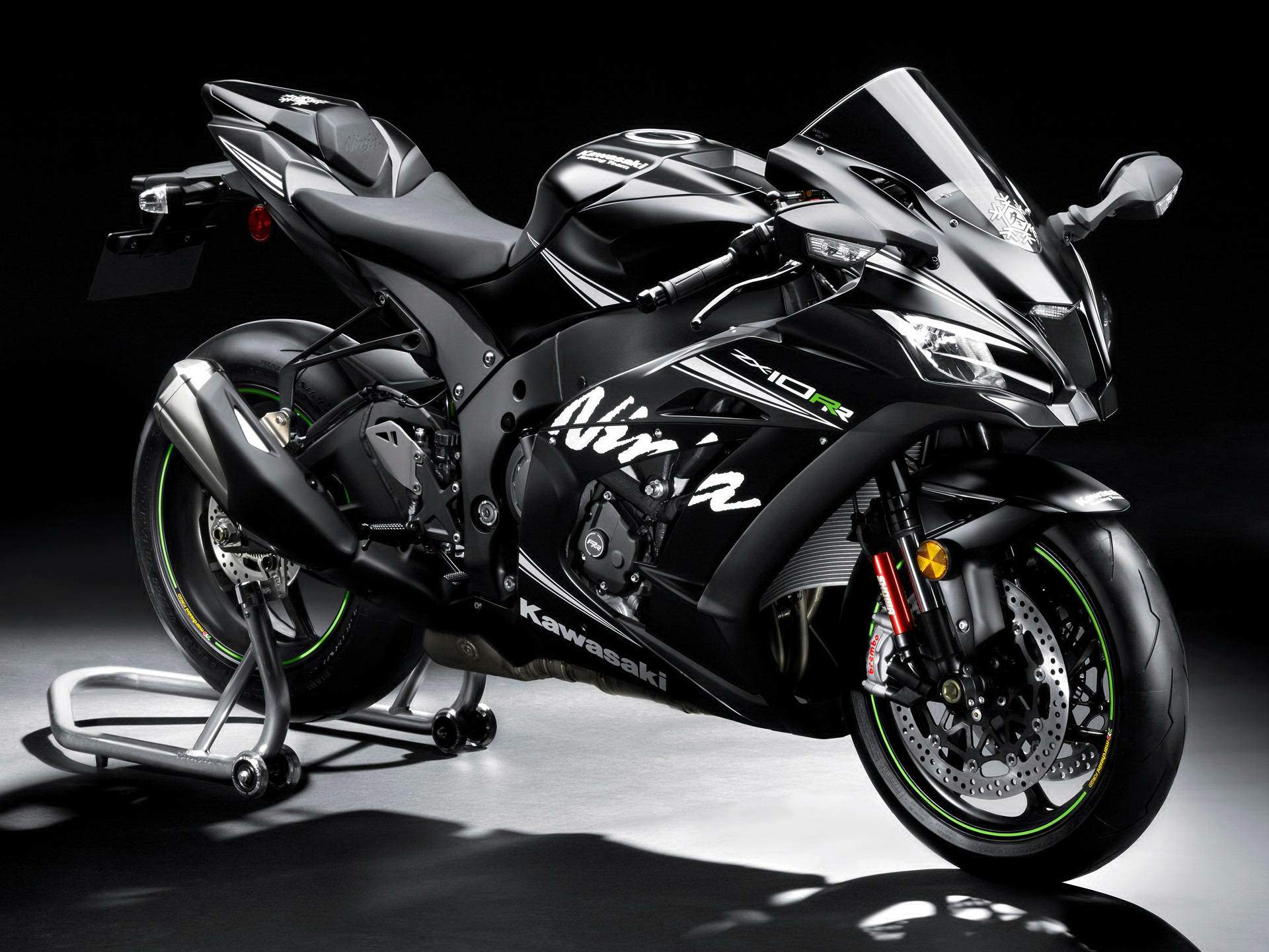
KLCM Kawasaki Launch Control Mode
The Kawasaki Launch Control Mode has three modes, which vary the level of intrusion via the ignition and intake air (throttle valves). Mode one offers less intrusion from the system but requires the rider to operate the clutch and throttle with greater sensitivity. Mode three allows the electronics to do more of the work while the rider simply drops the clutch with the throttle wide open. Mode two gives a setting between the first and third.
The Kawasaki Launch Control assists racers by optimizing acceleration from a stop by controlling engine output to prevent wheelspin and minimize font-end lift when leaving the starting line.
Using an indicator on the digital instrument display, the rider selects KLCM with the Power Mode also on FULL.
Kawasaki Engine Brake Control
The Kawasaki Engine Brake Control was first seen on the Ninja H2R motorcycle to work when the rider snaps the throttle shut. The rider can adjust the level of engine braking or turn the system off completely, via handlebar controls. This feature is intended for circuit use only and contributes to smoother braking and corner entry when used.
POWER MODES
The available levels are Full, Middle (80%) or Low (60%). These reduce power by the stated amount for street riding and are easily selected via the rocker switch on the left handlebar, allowing riders to select the power delivery to suit their preference.
CHASSIS
The front section of the main frame has been internally profiled to reduce induction noise, effectively using the interior as a resonator chamber. This has the effect of allowing the exhaust to be liberated, freeing significant horsepower from the engine.
SUSPENSION
Giving the Kawasaki Ninja ZX-10RR motorcycle a distinct advantage over its competition is the Showa Balance Free Fork (BFF). This is the first mass-production motorcycle application for the fork that was jointly developed with Showa in World Superbike competition. The 2017 Ninja ZX-10RR features revised front and rear suspension settings to match the single-seat configuration and new wheels and tires, and ensure smooth weight transfer during both deceleration and acceleration.
The main feature of the Showa BFF is that the design of the hydraulic system eliminates the pressure balance fluctuations typically found in conventional forks. With the BFF, the damping valves are located in one place � outside the fork legs in the damping force chamber. This allows the entire surface of the fork pistons to push the hydraulic fluid toward the valves in the damping force chamber, with nitrogen gas in the compression chamber pushing back against the oil, helping to maintain the balanced pressure inside the fork tube.
Compression and rebound damping are generated (and adjusted) completely independently from one another by the compression and rebound adjuster screws on the damping force chamber at the bottom of each leg. Locating the adjustment in this single place has resulted in a more focused design that greatly improves responsiveness. Spring preload adjustment is located on the top of each fork leg.
Other advantages of this system include better traction, improved low-speed comfort and increased frontend feel. When combined with the benefits in braking, frontend feel and comfort, riders will truly appreciate these forks on the racetrack.
The rear shock absorber is a Showa Balance Free Rear Cushion (BFRC) unit that also resulted from joint development in World Superbike competition. Just like the forks, the rear shock has a separate damping force chamber that houses the compression and rebound damping adjusters. By separating them, it again allows the entire damping piston to focus on hydraulic fluid movement. There is also external spring preload adjustment. The result is increased traction and superior shock absorption.
WHEELS, TIRES AND BRAKES
-
Seven-spoke forged Marchesini� aluminum wheels
-
Pirelli Diablo Supercorsa SP tires
The Ninja ZX-10RR features seven-spoke, multi-directional forged aluminium wheels, which were jointly developed with Marchesini. These wheels contribute to lighter handling � especially when changing direction. They offer a balance of high rigidity and a significantly reduced moment of inertia (thanks to a design that centralises mass at the hubs). Their machined finish also contributes to their high-quality appearance.
These Marchesini wheels can also be fit on standard Ninja ZX-10R models. Parts necessary for compatibility, such as front brake discs and speed sensor ring, will be made available as Kawasaki Genuine Accessories.
The Ninja ZX-10RR is outfitted with premium Pirelli Diablo Supercorsa SP tires, which greatly contribute to quicker lap times with additional grip feeling.
As another direct influence of Kawasaki�s World Superbike involvement, the Ninja ZX-10RR motorcycle has been fitted with a Brembo front braking system. This includes the very high specification M50 aluminium monobloc four-piston front calipers (with 30mm opposed pistons) and Brembo front rotors. The rotors are cross-drilled and have a circumferential groove in the outer edge to aid heat dissipation.
The Brembo components offer strong initial bite for circuit use and great feel through the lever. Each part is inspected and adjusted by Brembo to eliminate any ineffective (idle) stroke, providing strong braking force from the initial lever stroke. As a further measure to help provide excellent brake action, race-quality stainless steel braided lines have been fitted front and rear to help ensure direct feel when the brakes are applied.
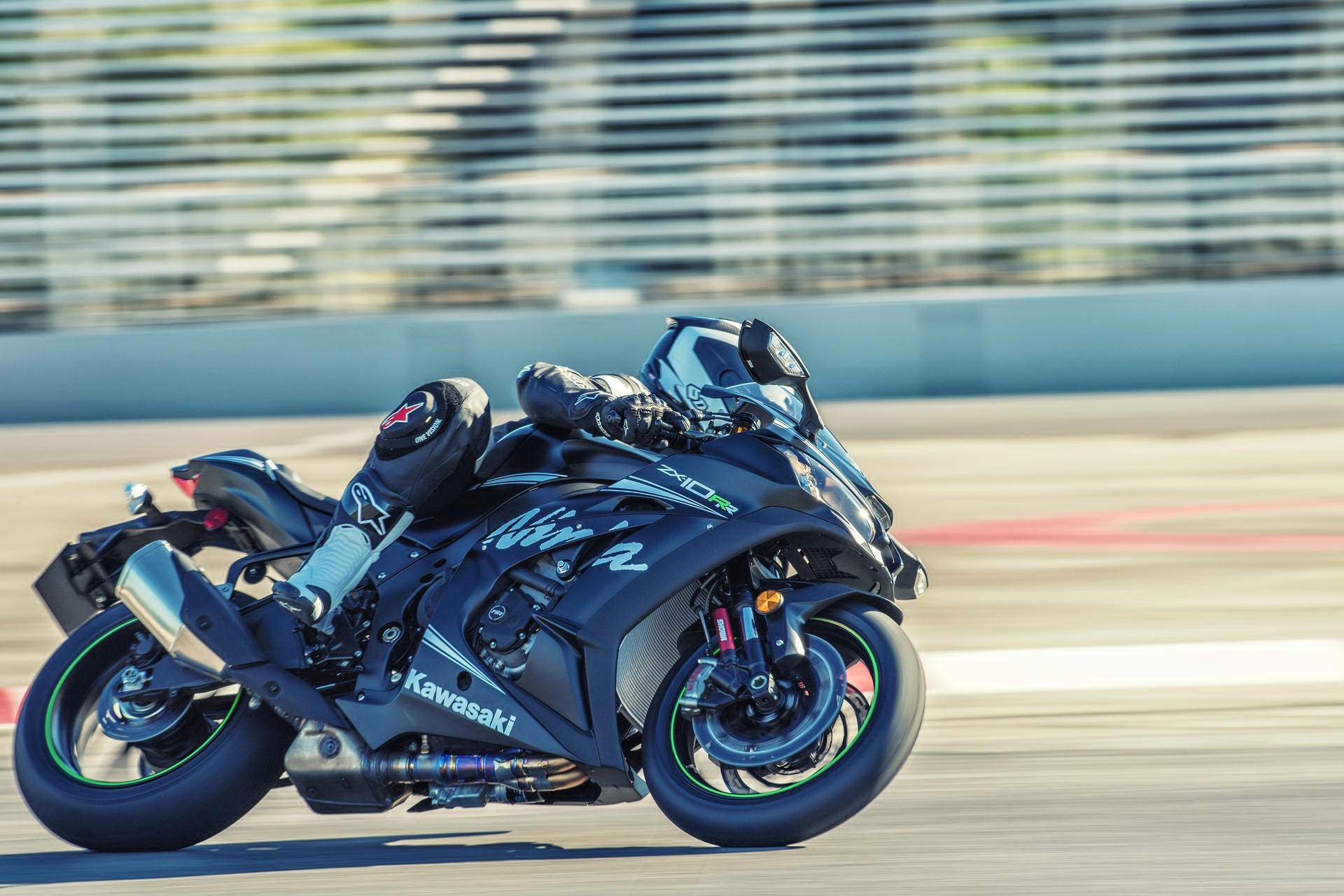
BODYWORK
-
Single seat
-
Rear aerodynamic seat cover
-
Special RR designation
Aiding in the ZX-10RR�s race-driven look is the paint scheme: Kawasaki Racing Team: Winter Test Edition. The Ninja ZX-10RR sportbike will be offered in the same paint scheme that the Kawasaki WorldSBK team uses for their off season test sessions, giving the vehicle a performance look very similar to its racing brother. The imposing flat black scheme features minimal white graphics, including a snowflake with the Japanese symbol for �winter� inside. Used for development test sessions only, once sponsorships are secured the livery changes to Kawasaki Racing Team colors and full promotional sponsor logos for race events.
The 2017 Kawasaki Ninja ZX-10RR features the same wind tunnel proven body work as its Ninja ZX-10R brother, but with more race-focused touches. The Ninja ZX-10RR includes special RR designations throughout the bike. The rear seat is replaced with an aerodynamic seat cover. The RR designation is stamped on the side engine cover as well as the ignition key, for little added touches of refinement.
COCKPIT AND CONTROLS
The main instruments on the Ninja ZX-10RR motorcycle�s LCD portion include the option to change the background color from black to white. There is also an IMU indicator, as well as Launch Control, Quick Shift and Engine Braking activation, plus gear position indicator, Power Modes, S-KTRC modes (and Off), low fuel level, Economic Riding Indicator, intake air temperature, odometer, dual trip meters, average fuel consumption, instant fuel consumption and a host of indicator lamps.
To select these functions, a rocker switch is located on the left handlebar that incorporates a �select� button to allow the rider to scroll through the functions.
ACCESSORIES
A wide variety of Kawasaki Genuine Accessories will be available for purchase through Kawasaki�s nationwide dealership network. These include Kawasaki Genuine Accessories Race Kit parts, to get your Kawasaki Ninja ZX-10RR even closer.
2017 Kawasaki Zx10rr Top Speed
Source: https://www.motorcyclespecs.co.za/model/kawasaki/kawasaki_zx10R_Hol_se_17.htm
